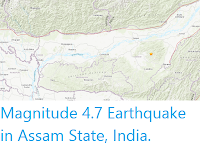At least sixty six people have died in flooding in Assam State associated with the annual Monsoon this year. Twenty six of the state's thirty three districts have suffered flooding, with around 3 573 000 people living in affected areas, of whom about 36 000 people from nineteen districts have been forced to flee their homes, and are currently housed in 629 relief camps. A number of animals, including two Rhinoceros, have reportedly drowned in the Kaziranga National Park and Tiger Reserve, which has been hit by severe flooding.
Flooding in Morigaon District, Assam. Press Trust of India.
Monsoons
are tropical sea breezes triggered by heating of the land during the
warmer part of the year (summer). Both the land and sea are warmed by
the Sun, but the land has a lower ability to absorb heat, radiating it
back so that the air above landmasses becomes significantly warmer than
that over the sea, causing the air above the land to rise and drawing in
water from over the sea; since this has also been warmed it carries a
high evaporated water content, and brings with it heavy rainfall. In the
tropical dry season the situation is reversed, as the air over the land
cools more rapidly with the seasons, leading to warmer air over the
sea, and thus breezes moving from the shore to the sea (where air is
rising more rapidly) and a drying of the climate. This situation is
particularly intense in South Asia, due to the presence of the
Himalayas. High mountain ranges tend to force winds hitting them
upwards, which amplifies the South Asian Summer Monsoon, with higher
winds leading to more upward air movement, thus drawing in further air
from the sea.
Diagrammatic representation of wind and rainfall patterns in a tropical monsoon climate. Geosciences/University of Arizona.
See also...








